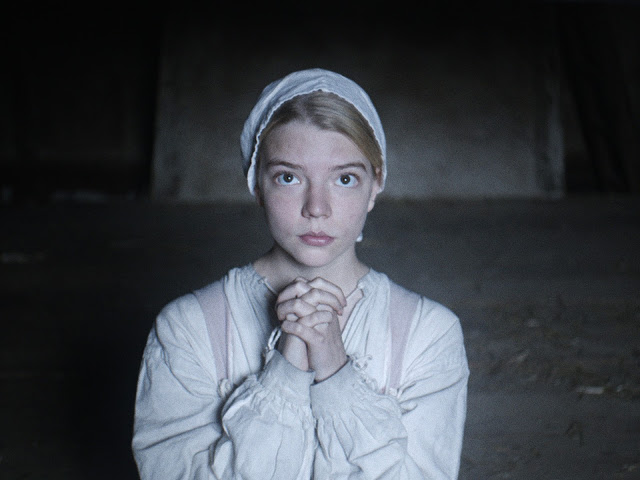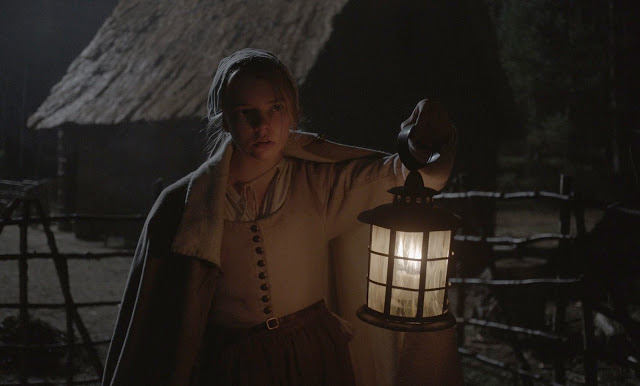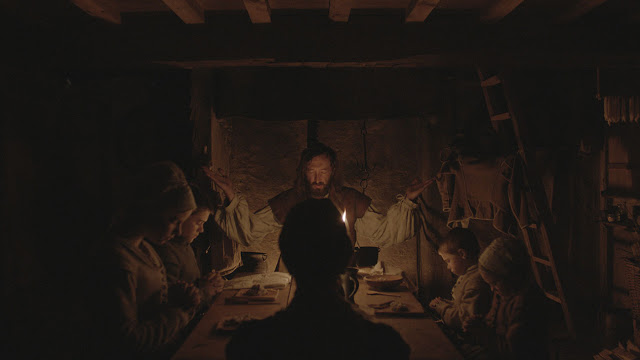Early in The Witch, Robert Eggers’s sly and skillful horror film, a man goes hunting with his 12-year-old son. They’re searching for game in the midst of a dark, ominous wood, but they also find time for some standard-issue father-son bonding. Only it isn’t quite standard-issue; when the man, William (Ralph Ineson), cautions the boy, Caleb (Harvey Scrimshaw), against the dangers of sleeping too late, he solemnly intones, “The devil holds fast your eyelids.” That delectable piece of diction encapsulates The Witch‘s dual preoccupations. It’s a movie about the danger of religious fervor, but it’s also about communication—what people say (and don’t say), and, more importantly, how they say it. As the adage goes, the devil is in the dialogue.
The Witch, which takes place in the 17th century, purports to base its tale of literal and allegorical horror on actual period sources. To that end, the characters speak largely in early-modern English, which means there are a great many thous, haths, and dosts. (Even the film’s marketing materials get in on the act, treating the title’s W as consecutive V’s.) This requires a small act of translation on the part of the audience—not unlike when listening to Shakespeare, you have to actively puzzle out the characters’ speech, rather than simply absorbing it. This assumes that you can hear it; the film’s sound design picks up the rustling of branches and the bleating of animals, often compelling you to strain your ears to comprehend every flavorful morsel of colonial argot.
But while parsing the language of The Witch is sometimes a struggle, it is never a chore. That’s because the rich, ornate dialogue is clearly the product of a painstaking filmmaker who cares deeply about his craft. That level of thoughtfulness extends to the other aspects of the picture’s production. Structurally, The Witch is chilly and disturbing, but as a piece of cinema, it is supple, striking, and even lovely.
Not that its characters know much warmth. Subtitled “a New England folktale”, The Witch opens with a brisk and efficient prologue, in which its central family is excommunicated from a plantation because of William’s “prideful conceit”. It then spends the remainder of its runtime on the family’s newly constructed farm, which is surrounded by—you guessed it—a spare and scary forest. Times are tough for this hardscrabble clan, which includes, in addition to William and Caleb: William’s wife, Katherine (Kate Dickie, Lysa Arryn on Game of Thrones); their 16-year-old daughter, Thomasin (Anya Taylor-Joy, very good); their toddler twins, Mercy and Jonas; and their newborn babe, Samuel. That’s a lot of mouths for a poor family to feed, though their number is quickly reduced by one when, during a beautifully staged game of peek-a-boo, baby Samuel mysteriously disappears.
That incident, a model of sure framing and ruthless economy, is the first of many sequences that highlight Eggers’s gifts for horror. A production and costume designer making his first feature, he loads The Witch with scene after scene of ravishing disquiet. As a narrative, the movie is uncomplicated; one misfortune after another befalls our family, which must battle not only supernatural forces of evil but also the far more insidious demons of arrogance, selfishness, and shame. But the film’s execution is casually sublime. Moments of visual simplicity—the backfiring of a rifle, the splitting of blocks of wood, the bounding antics of a terrifying goat named Black Phillip—achieve a level of portentousness, a sense of steadily encroaching doom. The Witch may not be petrifying—Eggers is too disciplined to punish his viewers with cheap shocks—but it is unsettling.
Yet while The Witch is nominally a horror movie, it is at heart a carefully observed family drama. The film’s relationships feel nurtured and authentic, even if they are also distressing and a little creepy (at one point, Caleb sneaks a peek at Thomasin’s cleavage, a sign of the repressed lust that eventually lands him in serious trouble). Pervading everything is the specter of religion; even the last syllable of Thomasin’s name echoes her family’s obsession with wickedness. But though its woebegone Puritans ardently believe in good and evil, The Witch is more complex than that. William, for example, is a man of abiding faith, and you might expect Eggers to cast him as the picture’s tyrannical villain—a domineering patriarch who puts the “fear” in God-fearing. But while he is certainly stern, he is also a just and tender father who happens to cling to scripture, and Ineson (also from Game of Thrones, as well as Britain’s The Office) plays him with a masterful combination of severity and self-doubt. His daughter, meanwhile, is a kaleidoscope of contradictions—playful and demure, rebellious and obedient, brave and terrified—and Taylor-Joy gradually unveils Thomasin’s teenage curiosity even as she foregrounds her dread.
There is plenty of the latter to go around, and not just of women on broomsticks. As the film’s story progresses and the family’s fate worsens, accusations of witchcraft are routinely flung around, at which point The Witch reveals itself as a cousin to The Crucible, the famed Arthur Miller play that deviously equated the Salem witch trials to the Red Scare. Eggers is less pronounced in his allegory, but he nevertheless uses his story’s supernatural elements to illustrate how mistrust can fester and fear can spread. (The easiest way to combat charges of witchcraft, it appears, is to accuse someone else of being a witch.) The difference is that, where Miller had no real interest in genuine horror, Eggers wants to scare the shit out of you.
He wants it a little too badly, it turns out. For the most part, The Witch nimbly balances between engrossing character study and outright horror flick, but in its final act, it tips too far toward the nightmarish. Eggers’s talent remains evident—Black Phillip’s demented prancing is likely to invade your dreams—but he sacrifices nuance in exchange for terror. It isn’t bad (Taylor-Joy is terrific throughout), but it also betrays the preceding sense of integrity.
Even so, The Witch delights in its very last passages, cresting with a climax that is both lurid and strangely beautiful. It’s the perfect capper to a meticulously composed movie, one that entertains even as it unnerves. It also feels like a reward, one that I was only too happy to seize. During this finale, a distinctly memorable supporting character poses a Faustian question: “Wouldst thou like to live deliciously?” Aye, The Witch. I daresay I wouldst.
Jeremy Beck is the editor-in-chief of MovieManifesto. He watches more movies and television than he probably should.




